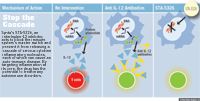Synta's Surprise
Pharmaceutical Executive
Synta is in a very unusual position: Two Big Pharmas have paved the way with proteins, while the small biotech follows with a pill.
Rheumatoid arthritis, psoriasis, multiple sclerosis, and Crohn's disease used to be considered individual niche markets with limited sales potential. Not anymore. Both the understanding of autoimmune disorders (and the inflammation that causes them) and the number of patients have grown dramatically in the past few years, creating a huge, broad-based market in which a single drug can become a blockbuster.

CEO Safi Bahcall founded Synta after working as a consultant in pharma mergers and investments.
The therapeutic category has become so important that analysts say Amgen's 2003 acquisition of Immunex (at $10.3 billion) was for the sole purpose of gaining Enbrel (etanercept), which recently added psoriasis to its rheumatoid arthritis indication. Enbrel and its competitors—Abbott's Humira (adalim-umab) and Johnson & Johnson's Remicade (infliximab)—are expected to generate more than $4 billion this year. But they are both TNF (tumor necrosis factor) alpha drugs, which means they are large-molecule antibodies (proteins) that require injection.
For the millions of people who suffer from autoimmune diseases (10 million in the United States alone), daily or weekly injections—for life—are a serious drawback. Those patients are all waiting for someone to develop a small-molecule oral version that they can take with their vitamins in the morning. The wait may soon be over.
The company poised to bring that drug to market is Synta Pharmaceuticals, based in Lexington, Massachusetts. Although it was recently named one of the industry newsletter Fierce Biotech's "Fierce 15," the company is not really a biotech. As noted, its lead candidate is a small-molecule interleukin-12 (IL-12) inhibitor, which short-circuits inflammation. The company is not exactly a startup either. Most of Synta's top scientists have been working together for a decade. They were originally part of Fuji Immuno-Pharmaceuticals (FIP), a Lexington-based drug discovery unit of Fuji Photo, which formed as a joint venture with Lan Bo Chen, a Harvard professor of cell biology.
In 1997, Fuji sold most of FIP—its library of compounds and its small-molecule discovery team—to the Japanese pharma Shionogi, which combined them into a new drug discovery subsidiary called Shionogi Bio-Research. (The rest of the operation went to Merck KGaA.) Then in 2002, the unit spun off from Shionogi and merged with Synta, a local two-year-old startup founded by Safi Bahcall.

Chief Medical Officer Matthew Sherman joined Synta earlier this year. He brings expertise in both the IL-12 gene and anti-cancer compounds.
Light and Swift
Bahcall's journey to pharma CEO is as quirky as his R&D team's history. He started out in academia, studying at Harvard, Berkeley, and Stanford, where he earned a PhD in theoretical physics. "Eventually, the learning curve flattened," he recalls. "I was looking for a new challenge, and I got very curious about the business world. So I took a job in management consulting with McKinsey & Company in New York. I worked both with pharmaceutical companies and with investment banks on strategic, operational, and organizational issues. It was a great training ground, and a great way to learn at close range from the successes—and the mistakes—of very experienced business leaders."
In 2001, Bahcall combined his interests to found a drug discovery company based on novel ion-channel research, technology in-licensed from Harvard's Dana-Farber Cancer Institute. Soon after, he got to know the scientists at Shionogi Bio-Research (and the projects they were working on) through his connections in the Boston academic community, then put together a financing package and led them into a merger.
"We put together a nontraditional group of institutional and individual investors, primarily experienced buy-out investors based out of New York, that were willing to purchase the business from Shionogi," Bahcall says. "A total of over $180 million has gone into the company, and $128 million came from the New York investor group." Bahcall believes it may be the largest equity financing for a private US biotech company in the past three years.
The faith for that investment may have been based on the experience and success of Synta's R&D team. Two drugs they discovered and developed (before the Synta merger) are now in late-stage clinical trials for an HIV indication, one licensed to Pfizer, and one still with Merck KGaA.

Stop the Cascade
Bahcall says the company's high skill-small size character is what gives it an edge: "We're a fully independent pharmaceutical business. I think the closest analogy would be to take a core piece of Merck or Pfizer's R&D group, put them in a building, free them of bureaucracy, and give them strong incentives to discover great new drugs. It's basically a similar chemistry-driven discovery operation, but with the advantage that we can move faster and are able to take the kinds of risks—and attract the high-quality entrepreneurial talent—that is an essential part of making breakthrough discoveries in medicine."
Clear Path
Since the merger, the R&D team has moved quickly on its most promising compound, the IL-12 inhibitor, also known as STA-5326. As R&D progresses, the team is in the fortunate position of having the trail cleared by other companies that are developing large-molecule drugs for the same target. Abbott Labs and Johnson & Johnson both recently announced positive data for the monoclonal antibodies they have in development to inhibit IL-12.
"Two Big Pharmas have just done much of the hard work and heavy lifting of telling us which diseases, which patients, and what trials will work," Bahcall says. "It puts us in a very unusual historical position: two Big Pharmas paving the way with proteins, while a small biotech fast-follows with a pill. That's the opposite of how the biotech industry developed."
In this case, being third to market—assuming all three products get approved—will not likely be a barrier to gaining market share, given the advantages of a pill over an injection. Finding doctors and patients for clinical trials is also not a problem. Bahcall describes a typical interaction: "We call up physicians and say, 'We have a cytokine inhibitor. We are interested in adding your site or your center to our clinical trial program.' They say, 'That's interesting, but I have four or five other protocols of injectable drugs for my patients.' Then we say, 'It's a pill.' They say, 'Sign me up.'"

The pharma industry is also starting to take note. "We've been cold-called quite often," says Bahcall. "People see on our website or hear at a conference that we have an oral IL-12 inhibitor, and they are very intrigued. So we have quite a few pharmaceutical companies that are waiting for us to tell them what the next step is."
Partnering with a Big Pharma is an option the company is weighing carefully. Synta has capital in place to start Phase III trials but is waiting to see how finances look down the road before making a decision to license out its intellectual property. Even though some clinicians have called STA-5326 a "slam dunk," it still has to prove itself. And the data will not be available until the middle of next year when Synta concludes its Phase II trials in psoriasis and Crohn's disease.
Depth and Breadth
To bolster its expertise, last March, Synta brought in Matthew Sherman from Wyeth (formerly the Genetics Institute) as its chief medical officer. At the Genetics Institute, Sherman not only worked on the clinical development of the recombinant human IL-12 protein, he also led the development team that brought Mylotarg (gemtuzumab) to market for acute myeloid leukemia.
"It's interesting, 10 years after working on recombinant IL-12 protein as a potential therapeutic, to be involved as the key point person for an IL-12 inhibitor," Sherman says. "I have a great love for it." He says the IL-12 marker is "the master switch for turning on the immune system. It is the main driver for the TH1 [T-helper 1] arm of the immune system that leads to a multiple of other cytokine inflammatory molecules that are released by the body and can cause a variety of different diseases." That's why IL-12 inhibitors have the potential to treat so many conditions. They target (and stop) the inflammation process in its early stages before it releases the floodgate of cytokines that cause various diseases. (See "Stop the Cascade.")
Sherman's experience will also be important for Synta's other key therapeutic interest: anti-cancer compounds. Also in Phase II trials is a small molecule (STA-4783) that stimulates cancer tumors to express "heat shock proteins" (HSPs). The HSPs cause the tumor to "light up" so the immune system can see it and attack it.
Bahcall describes how the drug works: "One of the reasons cancer is able to grow in an uncontrolled way is that it stays dark to the immune cells, to the internal police system. Our HSP 70 inducer stimulates the surface of tumor cells to express a flag or a beacon to the immune system that something is going wrong. And that protein is called a stress protein or heat shock protein. Those proteins create a signal to the native immune system in the body, like a homing device, that something is wrong and the police should come and take a look."
One caveat for the compound is that it works only as an adjunct to taxane cancer drugs—Taxol (paclitaxel) and Taxo-tere (docetaxel). With other anti-cancer compounds, such as doxorubicin and vincristine, it has no effect. The explanation is that taxanes also have an effect on the immune system, and they combine with the HSP 70 inducer for a "one-two punch." But considering that Taxol is the mostly widely used chemotherapy, the market potential for a "helper" drug could be quite lucrative. STA-4783 is currently being tested in non small-cell lung cancer, melanoma, and sarcoma.
"In the preclinical models, that fact, that it worked best in combination with taxanes, led us to believe that there may be some other effects that might be interesting to explore," Sherman says. The company isn't willing to reveal any more about the compound until it has "adequate intellectual property protection." But Bahcall has high hopes: "We are excited about this, because it is, I believe, the next step in the evolution of treating cancer."
Small-Scale Innovation
Synta's R&D team (of 75 people) is busy with nearly a dozen Phase I and II trials and also has preclinical projects in both asthma and diabetes. (See "Small Molecules for Big Dis-eases.") Bahcall credits the company's "running start" to an old-fashioned approach to discovery.
"The problem is that single proteins never work in isolation in the body. They are always in a complex ecosystem in a cell and in different activity states, depending on what disease you have or what type of patient you are," he explains. "What we do is a turbocharged version of the old pharma discovery approach rather than the current genomic-inspired fashion of 'start with the protein.' We believe that we have to look at the whole system, the properties of the cell, rather than individual proteins in isolation. So we start with the chemistry, and when we see compounds that have the desired behavior in the whole cell system, then we really drill down. We go inside the cell to improve our understanding of the biology and then use that understanding to improve the quality of the compound—absorption properties, potency, specificity. It is the rapid feedback loop between the biology and chemistry that is the key to high productivity and high quality of final compound."
Bahcall also believes that it is the ability to innovate that marks the distinction between biotech and pharma, not large versus small molecules. He compares the industry to the way baseball is set up with minor and major leagues, with the minor leagues having the responsibility of looking at "1,000 local high schools to find a few promising, young pitchers." Then the minor leagues, or biotechs, test and develop theearly stage talent, and eventually "feed" the most successful, grown-up talent to the major leagues, or Big Pharma. There is, however, the exciting possibility—if a club can hold on to the talent as it grows up—that the club could graduate from the minor to the major leagues.
Bahcall is clearly aiming for the major leagues. The company is privately owned, and its pipeline is totally proprietary. "We have a strong fortress of intellectual property protection around our discoveries, from composition of matter to method of use, synthesis, and in certain cases, mechanism of action. And these drug candidates are novel, in that they are not me-too drugs, variants of known products, where the competition is more intense. "These are first-in-class mechanisms, so we have the benefit of first-mover advantage and the potential to be not only first in class, but also best in class and dominating the eventual franchise. Retaining these rights is a very attractive value proposition for all of our stakeholders."
Bahcall admits that it is a temptation to keep it that way. But Phase III clinical trials are expensive and a licensing agreement with a partner may become necessary. "Next year it will probably make sense for us to pick up the phone, start the discussions, see if there is an arrangement which works both for us and for a partner," says Bahcall.
Small Molecules for Big Diseases Synta's pipeline of mostly oral drugs targets the big three: cancer, immune disorders, and metabolic diseases.

Addressing Disparities in Psoriasis Trials: Takeda's Strategies for Inclusivity in Clinical Research
April 14th 2025LaShell Robinson, Head of Global Feasibility and Trial Equity at Takeda, speaks about the company's strategies to engage patients in underrepresented populations in its phase III psoriasis trials.
Beyond the Prescription: Pharma's Role in Digital Health Conversations
April 1st 2025Join us for an insightful conversation with Jennifer Harakal, Head of Regulatory Affairs at Canopy Life Sciences, as we unpack the evolving intersection of social media and healthcare decisions. Discover how pharmaceutical companies can navigate regulatory challenges while meaningfully engaging with consumers in digital spaces. Jennifer shares expert strategies for responsible marketing, working with influencers, and creating educational content that bridges the gap between patients and healthcare providers. A must-listen for pharma marketers looking to build trust and compliance in today's social media landscape.